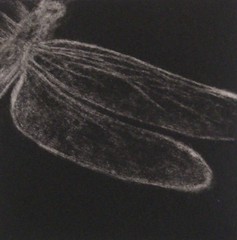 Name: Imogen Duthie
Name: Imogen DuthieEtsy: mezzotint.etsy.com
Flickr: www.flickr.com/mezzotint
Brief Bio
I live in Barcelona with my partner and work at home as a translator. I have always been interested in art in some way or other and, when I was a kid, I was into oil painting, pastels and charcoal, and took quite a few lessons. However, after I decided I would not study art, for some reason I abandoned the whole idea for a very long time. I went on to study Archaeology at University (some of my linocuts are inspired by archaeological field drawings, for instance “Hachures”) and have worked variously as an archaeologist, an English teacher and now a translator. I do printmaking in a workshop in the town centre, where I have learned the basics and made a bit of progress in the past couple of years. I started off taking classes from printmaker Rosa Brugulat (who unfortunately has very little presence on the Internet, despite my offers to help!), and now I basically experiment by myself when I get a chance.
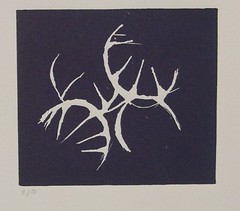
How did you get started in printmaking?
I had always loved the idea of printmaking, but knew very little about what it involves until I started doing some lessons. When I first came to Barcelona, I poked my nose into Rosa’s lovely shop, on a narrow little street in the Gothic quarter. I was attracted to the gorgeous prints hanging from the walls, and to her very large, old-fashioned looking press. When I moved again to Barcelona a couple of years later, one of the first things I did was fix up some etching classes with her. She taught me some of the basics of printmaking – a bit of hard ground and soft ground etching, aquatints, linocutting, how to cut my own paper, how to mix my inks and so on. She also taught me a bit about her specialty, viscosity printing, which she refers to as “the Hayter technique”. She also introduced me, albeit via a book of hers and not personally, to the idea of mezzotint, and I got hooked.
Describe where you work.
I mostly prepare the plates at home and then go into the workshop, generally at the weekend. I am thinking of getting myself a small portable press because I think I will be more productive. As I am currently concentrating on linocuts and mezzotints, I can easily work on the plates at home. I wish I had a little studio of my own, but living in Barcelona, things aren’t cheap!
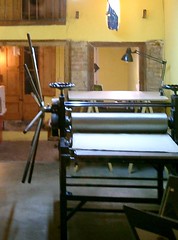
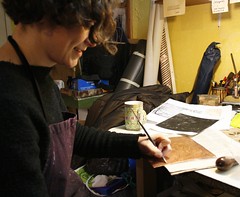 Please describe the process of mezzotint for those who might not be familiar with it.
Please describe the process of mezzotint for those who might not be familiar with it.With mezzotint, you prepare a plate by creating a finely grained texture all over the plate with what is known as a mezzotint rocker. It requires going over the plate in several directions with the rocker, until you reach a texture so dense that if you were to print it at that point, you would get pure black. Then, with scraper and a burnisher you flatten certain areas in order to create your design – the flatter you get them, the whiter they will be. It sort of works the opposite way to “normal” etching, because you work from black (through grey) to white.
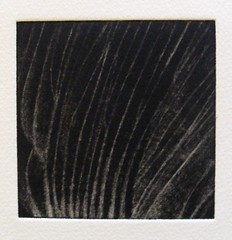
What drew you to mezzotint specifically? Why choose that method over other printmaking or specifically, other intaglio methods?
I think what drew me to mezzotint was that it looked like a very old-fashioned kind of printmaking, and one that takes patience. I like that it takes a long time to finish a plate, and I feel very much like I am “making” something. I also absolutely love the tones it gives – the range of greys and blacks is just lovely, and I like the textures that come out of it. I have basically taught myself mezzotint, as no one I know has done it themselves; I am sure that there are many things I do that wouldn’t be regarded by experts as “the right way” to do things, but I take delight in exploring and enjoying. Also, mezzotint was originally used for very precise portraits, and printmakers used to very carefully plot the whole picture onto the plate – there are a few Japanese mezzotint artists now who also create incredibly precise, technically stunning, pieces. However, what I love is actually its “smokiness” rather than its precision. I like not being too precise with lines – I like leaving that side of things to linocuts. With mezzotints I like a bit of blurriness, a bit more like some of the effects you get with aquatint.
 Describe using the viscosity method in printmaking.
Describe using the viscosity method in printmaking.Viscosity printing is great fun, though it can often be quite frustrating if you want to be specific about where the different colours go! Basically it involves printing one plate with 3 colours in one go. Certain areas of the plate should be left in acid for quite a while so as to create different levels on the plate. When it comes to printing, you ink up your plate in the normal way, choosing one colour for the intaglio (in this case red), and then you choose two other colours to apply on the plate with rollers (the rollers need to be big enough so as to not go over the plate twice, otherwise it doesn’t work, as it smudges). The lighter colour is applied first with a hard roller, and the ink should be made quite oily and runny. In the case of the print here, the ink was pale yellow. Then, the third and final ink, in this case an aquamarine blue is applied with a softer roller, and has no oil added at all. The different oil contents of the inks and the different hardness of the rollers mean that the inks repel each other, and the different colours enter different bits, creating very interesting results. It requires quite a lot of patience, but it is very rewarding.
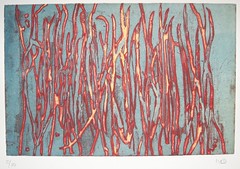 What's your creative process for any given print? (eg. sketch first? Pre-planned or free-form?)
What's your creative process for any given print? (eg. sketch first? Pre-planned or free-form?)I don’t sketch at all. With linocuts I might vaguely plot things down on the plate with a pencil, but it often gets rubbed out pretty soon, and I end up doing free-form mostly. I know what effect I want to get, but I am also quite interested in exploring what happens when I get started, and I am open to changing my mind.
In the case of the pomegranate, I looked at some photos, and then created my own pomegranate on the plate as I went along.
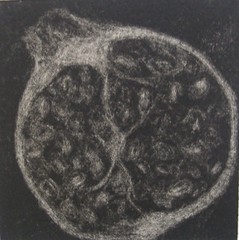 What do you enjoy most about printmaking?
What do you enjoy most about printmaking?There is something very special about making an image on a plate and then transferring it to paper, and I am not entirely sure why that is more appealing to me than simply drawing or sketching it. I think I love the moment where I carefully lift the print off the plate to see how it has turned out.
What's your least favorite part of the process?
To be honest, I can’t really say I have a least favourite part. I guess perhaps cleaning up and tidying up after myself!
What are your inspirations (other artists, people, places, events, etc.)?
I think I am inspired by organic patterns – I wasn’t particularly aware of this until recently, when I realised that a lot of the things I do have repetitive patterns resembling what I think of as very primitive life forms (or also deep sea life). I often like the idea of doing close-ups of a world that extends beyond. And in terms of other artists, I adore Goya and Rembrandt and Picasso – traditional, perhaps, but I every time look at them I think how on earth...?!
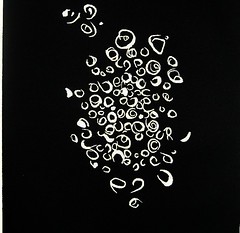 How has your work changed and evolved since you started?
How has your work changed and evolved since you started?Well, that’s fairly simple really – it actually took me quite a while to do things I actually liked. I would often look at a print I had done, and think, “I am not sure why I have done this, it’s not me at all!”. I am very happy that I have managed to teach myself the basics of mezzotint, and I feel like I am getting better. I am definitely more confident.
 How do you get past creative slumps?
How do you get past creative slumps?I have so little time to do etching that fortunately I don’t have creative slumps, just not enough time to do everything I want to do!
How do you promote your work?
Etsy is my only online shop. I also have a basic Trunkt account – but I haven’t really been prepared to invest much more money in it, because I do so little. However, the workshop is also a shop, and some of my prints are selling there. I have also made myself some little Moo cards, so I am now feeling a little more entrepreneurial, but I have a long way to go...!
Any other comments or advice for others who want to try making hand-pulled prints?
Be patient, don’t be worried if your first attempts look awful (mine certainly did), and enjoy it. I couldn’t live without it now.
7 comments:
Beautiful images and prints and a lovely interview!
Thank you Amie for posting that up! And thank you mizu designs! This blog is really looking good, and so varied!
Thanks for participating, Imogen. I absolutely love the viscosity print, but I also really enjoy your mezzotints (particularly the octopus-themed ones!)
What beautiful prints. I love mezzotints, but was never able to master the technique myself.
Thank you Yulianna! - I have a looooong way to go before I feel I have mastered it, but it's great fun learning! :)
I finally got my teacher Rosa Brugulat on Etsy! Her shop is http://rosabrugulat.etsy.com. There is not much on there, but I am assured more will come.
Knock! Knock! Hi there!
World is soooooo little!!!
How´re you doin´newbie aunt? Your work is really good!!! Hope to see ya soon!
Regards
Toni
Post a Comment